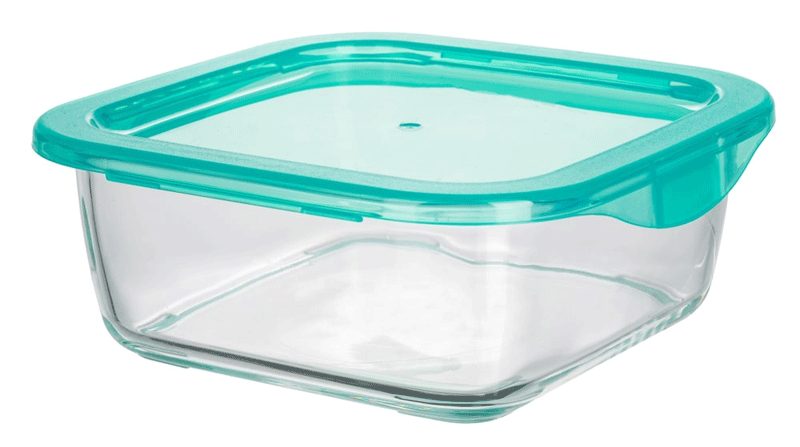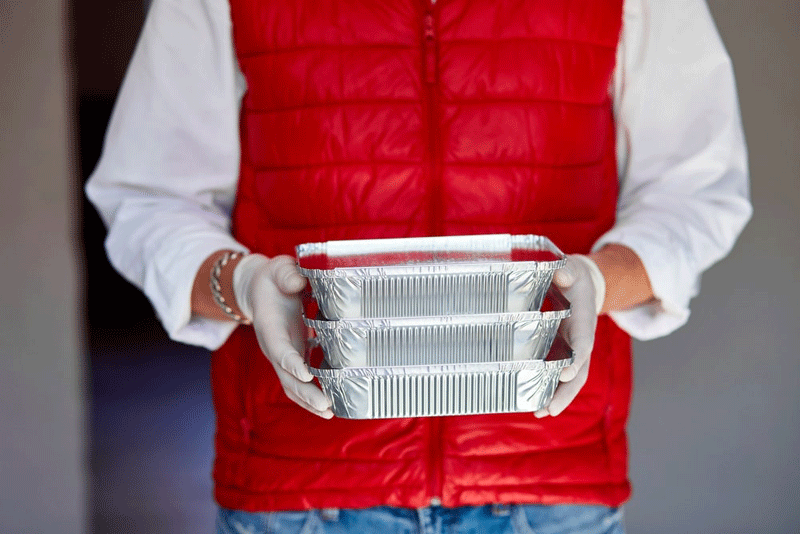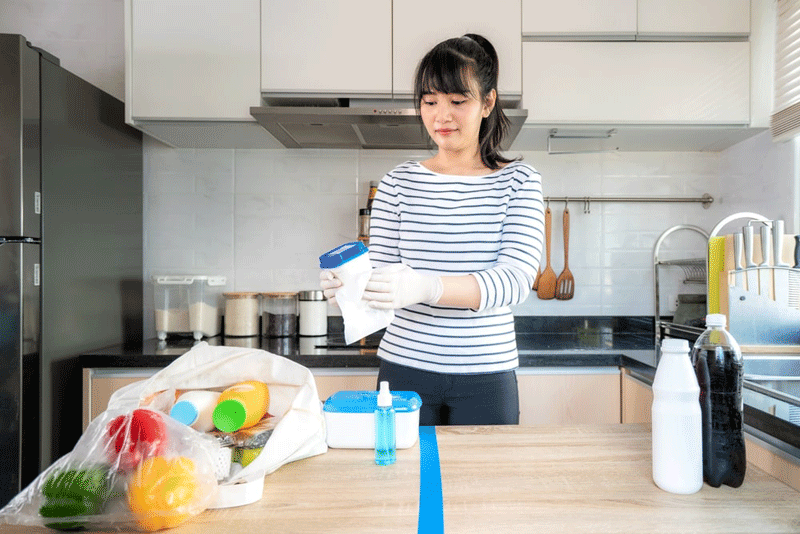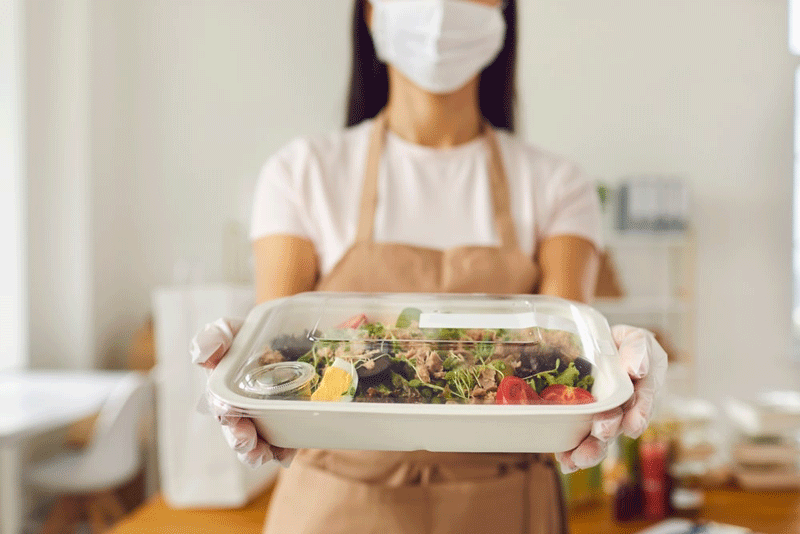
Safe Handling and Storage Tips for Clear Food Containers
Are you constantly annoyed by leftover food spoiling too soon? Or perhaps nervous about storing food safely, wondering if your family's health might be at risk? KitchenDance is here to banish these worries for good! Dive into this insightful blog post, where we provide a comprehensive guide on the safe handling and storage of clear food containers, ensuring both perfect preservation and high hygiene standards. Say goodbye to unnecessary food waste and say hello to an efficient, safer kitchen experience.
To safely handle and store clear food containers, it is important to wash them thoroughly with warm, soapy water before use. Store them in a clean, dry place away from direct sunlight and heat sources. Avoid exposing them to extreme temperatures as it can cause warping or cracking. Additionally, make sure to avoid using abrasive scrubbers or harsh chemicals that can damage the plastic. Finally, always check the manufacturer's recommendations for specific handling and storage instructions for your brand of clear food container.
Understanding Clear Food Containers

Clear food containers are a popular choice for storing and preserving various food items. These containers are typically made of transparent materials like glass or plastic, allowing you to easily see the contents inside. Why is understanding clear food containers important?
Firstly, clarity is essential for identifying the condition of stored food at a glance. Being able to see the contents without opening the container reduces the risk of exposing it to unnecessary air or contaminants. Additionally, clear containers allow you to organize your pantry or refrigerator more effectively by visually identifying different types of food items and expiration dates.
When it comes to choosing between glass and plastic clear food containers, there are a few factors to consider. Glass containers tend to be more durable and resistant to staining or absorbing odors compared to plastic. They are also microwave-safe and can often be used for baking. On the other hand, plastic containers are lighter, more affordable, and generally have lids that create an airtight seal. However, keep in mind that plastic may deteriorate over time or when exposed to heat.
For instance, if you frequently pack lunches or snacks that need to be microwaved at work or school, using glass containers could provide you with an added advantage in terms of convenience and versatility.
It's worth noting that some studies have raised concerns about the potential negative effects of certain types of plastic on health. While these findings are not yet conclusive, individuals may choose to transition from plastic containers to other materials like glass or silicone. However, it's important to acknowledge that this transition can be expensive due to the initial cost difference between these materials.
Now that we have a better understanding of clear food containers and their significance in food storage, let's explore some safe handling techniques to ensure hygiene and preservation.
Clear food containers are important for easily identifying the condition of stored food and organizing your pantry or refrigerator. When choosing between glass and plastic containers, consider factors such as durability, microwave-safety, and airtight seals. While some studies have raised concerns about the potential negative effects of certain types of plastic on health, individuals may choose to transition to other materials like glass or silicone. Safe handling techniques should be utilized to ensure hygiene and preservation of food items.
Safe Handling Techniques for Food Containers

Proper handling of clear food containers is essential for maintaining both hygiene and prolonging the freshness of the stored food. Let's delve into some best practices for safely handling these containers.
Minimizing Temperature Fluctuations: Clear food containers, especially those made of plastic, can be sensitive to temperature changes. Extreme temperatures, such as freezing or exposing them to high heat, may cause the containers to warp or crack. To avoid this, it's important to handle and store clear food containers in areas with stable and moderate temperatures. For example, placing them on shelves away from direct sunlight or heat sources is recommended.
Take Care When Stacking: When storing multiple clear food containers, ensure they are stacked properly to prevent unintentional damage. Avoid excessive stacking that could lead to pressure on the containers below. If you are using glass containers, try utilizing stackable baskets or boxes in your pantry or fridge for added support.
Clean Thoroughly: Regular cleaning of clear food containers is crucial for maintaining hygiene and preventing the buildup of bacteria and odors. Follow manufacturer instructions for cleaning or hand wash with mild soap and warm water. Pay attention to any crevices or corners where food particles may hide. Allow the containers to dry completely before reusing or storing.
By implementing these safe handling techniques, you can maintain the integrity and cleanliness of your clear food containers, ensuring that your stored food remains fresh and safe to consume.
Minimizing Temperature Fluctuations
Ensuring proper temperature control is vital for preserving the quality and safety of your food stored in clear containers. Imagine this: You diligently prepare a delectable dish, store it in a clear food container, and place it in the refrigerator, only to find the texture ruined and flavors altered when you take it out to enjoy later. This unfortunate scenario can be prevented by following some best practices for minimizing temperature fluctuations.
First and foremost, avoid placing hot food directly into clear containers and then immediately transferring them to the refrigerator or freezer. The sudden change in temperature can cause stress on the container material and potentially lead to breakage or warping. Allow hot food to cool down to room temperature before transferring it to clear containers and refrigerating them.
Additionally, when storing clear containers in the refrigerator or freezer, make sure they are not positioned near any vents or fans that can cause rapid temperature changes. Exposing the containers to drastic shifts in temperature may compromise their integrity and increase the risk of damage.
It's also crucial to remember that clear food containers are not suitable for use in ovens or microwaves unless explicitly labeled as microwave-safe. Subjecting these containers to high heat can result in melting or leaching of chemicals into your food.
By taking steps to minimize temperature fluctuations during storage, you can maintain the quality, taste, and safety of your stored food items for longer periods.
Now that we have addressed the importance of temperature control let's move on to another essential aspect of safe handling and storage - sanitizing your containers.
Sanitizing Your Containers

To ensure hygienic conditions for your food storage, regular cleaning and sanitization of your clear containers are crucial. Picture this: You open up a container expecting fresh leftovers only to be greeted by an unpleasant odor or sticky residue. To avoid such situations and keep your stored food safe, here are some best practices for sanitizing your containers.
Start by emptying the container and removing any remaining food residue. Rinse it thoroughly with warm water to loosen any stubborn particles. For sticky residues, add a few drops of dishwashing liquid to the container, fill it with warm water, and let it soak for a few minutes before rinsing again. This step helps remove oils and prevents lingering odors.
After washing, sanitize your containers either by using a mild bleach solution or by utilizing a dishwasher if the containers are dishwasher-safe. To prepare a bleach solution, mix one tablespoon of bleach with one gallon of water. Submerge the containers in this solution and let them sit for a few minutes before rinsing thoroughly with water.
If you prefer using a dishwasher, place your clear containers on the top rack to avoid direct heat exposure that could lead to warping or melting. Ensure that the dishwasher is set to high-temperature wash and sanitize mode for effective cleaning.
Once clean and sanitized, allow your clear containers to air dry completely before stacking or storing them again. By following these sanitation practices, you can maintain a hygienic environment for your stored food items while preventing cross-contamination and unpleasant surprises when it's time to enjoy them.
A study conducted by the University of Arizona found that over 20% of foodborne illness outbreaks result from improper food storage.
According to the National Sanitation Foundation, bacteria are more likely to grow in spaces cluttered with improperly stored food containers – making foodborne illness a bigger risk.
Research from the National Resources Defense Council shows that proper storage can reduce household food waste by up to 20%.
Efficient Storage of Clear Food Containers
Proper storage of clear food containers is crucial to maintain hygiene and ensure the preservation of food. By following efficient storage practices, you can maximize the lifespan of your containers and minimize the risk of contamination.
One key aspect is organizing your food containers in a systematic manner. Consider using stackable containers that can nest inside one another when empty, helping to save space in your kitchen cabinets or refrigerator. This allows for easy access and minimizes clutter. Additionally, you can use dividers or designated storage containers to keep lids separate from the bases, making it simpler to find matching sets.
Storing clear food containers in an orderly fashion also helps with visibility. Arrange them in such a way that you can quickly identify their contents without needing to open each container individually. Labeling or color-coding your containers can further enhance visibility and streamline meal preparation.
Another essential factor to consider is cleanliness. Always wash your clear food containers thoroughly between each use to avoid bacterial growth and cross-contamination. Follow the recommended cleaning procedures provided on product literature or packaging. It's also good practice to allow the containers to air dry completely before stacking or storing them, as moisture can lead to mold or mildew.
When storing leftovers in clear food containers, ensure they are cooled down properly before placing them in the refrigerator. Large quantities of hot leftovers should be separated into smaller containers to expedite cooling. Venting the lids slightly during the cooling process also aids in preventing condensation buildup. Once the food has sufficiently cooled, tighten the lid securely to maintain freshness and prevent odors from spreading.
By implementing these efficient storage practices, you not only promote a clean and organized kitchen environment but also prolong the lifespan of your clear food containers while ensuring the safety of stored food items.
Identifying Microwave Safe Containers

Using microwave-safe containers is vital to prevent hazardous situations, such as container warping, melting, or the release of harmful chemicals into your food. When selecting containers for microwave use, it's essential to look for certain indicators that signify their safety.
The first step is to identify the materials used in the container's construction. Microwave-safe containers are typically made from glass, ceramic, or microwave-safe plastic. These materials have been tested and manufactured to withstand the heat generated in microwave ovens without adverse effects.
To determine if a plastic container is microwave-safe, you can check for the "microwave-safe" symbol on the bottom. This symbol consists of wavy lines representing radiation waves. If this symbol is present, it indicates that the container has undergone testing and is suitable for use in the microwave.
It's important to note that not all plastic containers should be used in the microwave. Some plastics can leach harmful chemicals into your food when exposed to high temperatures. Look for containers labeled with numbers 1, 2, 4, or 5 inside a recycling symbol. These plastics are generally considered safe for microwave use.
Moreover, refrain from using containers that show signs of damage, such as cracks, warping, or discoloration. These indications suggest that the container may not withstand the heat generated by the microwave and could pose safety risks.
Remember that lids or covers used with microwave-safe containers should also be labeled as safe for microwave use. It's advisable to remove any metal elements or foil before placing containers in the microwave oven to prevent sparks or fire hazards.
Keeping these guidelines in mind when choosing containers for microwaving ensures the safety of both your containers and your food, providing peace of mind while utilizing this convenient method of heating meals.
Assessing Container Durability
When it comes to food containers, durability is a crucial factor to consider. You want containers that can withstand the rigors of daily use and maintain their integrity over time. Assessing container durability involves examining various aspects of the material, design, and construction.
One key aspect to consider is the material used for the container. Different materials have different levels of durability. Plastic containers, for example, can range from flimsy and prone to cracking or warping to sturdy and long-lasting. Look for containers made from high-quality materials such as BPA-free plastics or tempered glass, as they are more likely to retain their shape and resist damage.
Imagine you're meal prepping for the week, filling your food containers with delicious homemade meals. During transportation to work or school, a less durable container might crack or leak, causing unwanted messes and potentially wasting your carefully prepared food.
Next, examine the design and construction of the container. Look for features like reinforced corners or snap-on lids that provide additional strength and stability. Containers with secure closures help prevent leaks and spills, ensuring your food stays fresh and intact.
It's also important to consider whether the container is microwave-safe or freezer-safe if you plan on using it for reheating or freezing leftovers. Some materials may not fare well under extreme temperature changes, leading to cracks or other forms of damage.
By assessing these aspects of container durability, you can make informed choices when selecting food storage solutions that will stand the test of time, ensuring your food remains safe and well-preserved.
Now that we've covered the importance of assessing container durability in maintaining food safety let's delve into best practices for maintaining hygiene and preserving your stored food.
Maintaining Hygiene and Food Preservation

Proper hygiene and food preservation go hand in hand when it comes to storing food in clear containers. Keeping your containers clean and following essential practices helps prevent bacterial growth and maintain the quality of your stored food.
Start by thoroughly washing your containers before their initial use. Use warm, soapy water and a non-abrasive sponge or cloth to clean both the container and its lids. Rinse them well to remove any soap residue, as it can affect the taste and odor of your food.
Think of cleaning your food containers like washing your hands before handling food – it's an essential step in maintaining cleanliness and preventing contamination.
Regularly washing your containers after each use is equally important. Avoid leaving food residue or stains in the container, as these can become breeding grounds for bacteria. Pay extra attention to corners, crevices, and areas around the lid where food particles may accumulate.
Proper storage techniques also play a significant role in maintaining hygiene and preserving your food. Ensure that all perishable items are appropriately sealed before storing them in the containers. This prevents cross-contamination and keeps your food fresher for longer.
For instance, if you're storing leftover spaghetti sauce in clear food containers, make sure the lid is tightly sealed to prevent any leakage or mingling with other ingredients in your refrigerator.
Consider using separate containers for different types of food to avoid flavor transfer or cross-contamination. Raw meat, for example, should always be stored separately from ready-to-eat foods to minimize the risk of bacterial contamination.
Lastly, be mindful of how long you store food in clear containers. Even with proper hygiene practices, certain foods have shorter shelf lives than others. Regularly check for signs of spoilage such as unusual odors, discoloration, or texture changes and discard any spoiled or expired food promptly.
By following these best practices for maintaining cleanliness and preserving your stored food, you can ensure that your clear containers not only keep your meals organized but also contribute to a healthy and enjoyable dining experience.
Preventing Cross-Contamination
When it comes to safe handling and storage of clear food containers, preventing cross-contamination is crucial for maintaining hygiene and ensuring the preservation of your food. Cross-contamination occurs when bacteria from one food item transfers to another, potentially leading to foodborne illnesses. To mitigate this risk, follow these best practices:
Firstly, always separate raw meats, poultry, and seafood from other foods. This can be done by placing them in their own designated clear food containers or using separate storage areas in the refrigerator. This prevents any potential bacteria from the raw items from coming into contact with ready-to-eat foods like fruits or vegetables.
For instance, imagine you have purchased some fresh chicken breasts and are storing them in a clear container. Before placing them in the fridge, make sure to wrap them securely in plastic wrap or place them in a sealed bag to prevent any juices from dripping onto other foods.
Secondly, be mindful of using separate utensils and cutting boards for different types of foods. By designating specific tools for each category, such as one set for meat and another for produce, you eliminate the risk of cross-contamination through surface contact.
Consider this scenario: You are preparing a salad consisting of lettuce and tomatoes using a cutting board that was just used to chop raw chicken. Not only does this contaminate the vegetables with potential bacteria but also poses health risks when consumed.
Another aspect to consider is proper hand hygiene. Always wash your hands thoroughly with soap and water before handling any food items or touching any clear food containers. This simple practice reduces the likelihood of transferring harmful bacteria from your hands onto the food.
Picture yourself preparing a meal where you need to touch various ingredients like onions, garlic, or spices with your bare hands. Failing to wash your hands before handling these items may introduce contaminants that lead to foodborne illnesses.
By following these preventive measures and being vigilant about cross-contamination, you can ensure the safety and hygiene of your food storage practices.
Ensuring Freshness with Proper Sealing
Proper sealing is an essential practice in preserving the freshness and quality of food when using clear containers. It helps to maintain the integrity of your ingredients and prevents exposure to air, moisture, and external odors. Here are some tips to ensure freshness through effective sealing:
Firstly, choose clear containers with secure and airtight lids. This ensures that there are no gaps or openings where air or moisture can enter, protecting your food from spoilage. Look for containers with high-quality seals or snap-on lids that create a tight barrier against external elements.
Imagine storing leftover pasta sauce in a clear container with a loose-fitting lid. The exposure to air could lead to the sauce oxidizing more quickly and losing its flavor and texture.
Secondly, before sealing your clear food containers, make sure the food is cooled down to room temperature or chilled in the refrigerator. Placing hot foods directly into sealed containers creates condensation inside, which can promote bacterial growth.
For instance, after cooking a batch of soup, allow it to cool for a while before transferring it to a clear container and sealing it. This reduces the risk of contamination and prevents excess moisture buildup.
Lastly, when sealing your clear food containers, remove as much excess air as possible. This minimizes oxidative reactions and maintains the quality of your food for longer periods. Consider using vacuum-sealing techniques or pressing plastic wrap tightly against the surface of foods like dips or sauces before sealing the container.
If you are storing homemade guacamole in a clear container, press plastic wrap directly onto its surface before securing the seal. By limiting contact with air, you prevent the avocado from browning and preserve its freshness.
By practicing proper sealing techniques, you can extend the shelf life of your food while ensuring that it remains fresh and safe for consumption.
What are some common mistakes people make when handling or storing clear food containers?
Some common mistakes people make when handling or storing clear food containers include not thoroughly cleaning them before use, exposing them to direct sunlight or high temperatures, and overcrowding the containers. These mistakes can lead to bacterial growth, deterioration of food quality, and contamination. According to a study by the Food and Drug Administration (FDA), failure to properly clean food containers contributes to around 20% of foodborne illness cases each year.
Are there any regulations or industry standards in place regarding the use and storage of clear food containers?
Yes, there are regulations and industry standards in place regarding the use and storage of clear food containers. These standards ensure that clear food containers are manufactured using safe materials that do not contaminate the food and comply with health and safety guidelines. Additionally, these regulations outline proper handling and storage practices to maintain hygiene and preserve the quality of the food. According to a survey conducted by the Food Safety and Inspection Service, 86% of food establishments reported following these industry standards for clear food container usage.
How can you properly clean clear food containers to ensure their safety for reuse?
To properly clean clear food containers for reuse, start by rinsing them with hot water to remove any leftover food particles. Then, use a mild dish soap and a non-abrasive sponge to scrub the containers thoroughly. Pay extra attention to the edges and corners where bacteria can hide. Rinse again with hot water and allow the containers to air dry or pat them dry with a clean towel. According to a study published in the Journal of Food Protection, proper cleaning and sanitization reduces the bacteria and microbial load on food containers, making them safer for reuse.
What types of clear food containers are safest for storing various types of food, such as liquids or perishables?
When it comes to storing different types of food, the safest clear food containers vary depending on the specific needs. For liquids, such as soups or sauces, it is recommended to use BPA-free glass containers with tight-sealing lids, as they are non-toxic and prevent leaks. For perishable foods like meats or dairy products, airtight plastic containers made of high-quality food-grade materials like polypropylene can help maintain freshness and reduce spoilage risks. According to a study published in the Journal of Food Protection, clear glass containers have been found to be more effective at preserving nutritional quality and maintaining hygiene compared to other materials.
Are there any types of foods that should not be stored in clear food containers due to safety concerns?
Yes, there are certain types of foods that should not be stored in clear food containers due to safety concerns. Specifically, highly acidic or fatty foods, such as tomatoes or oily dressings, can interact with the plastic material of the container, potentially leaching harmful chemicals into the food. Moreover, exposure to light can promote oxidation and degradation of nutrients in some foods. According to a study published in the Journal of Food Protection (2017), storing tomato-based products in clear plastic containers increased the migration of bisphenol A (BPA) by 17%, highlighting the importance of using opaque containers for such items.


